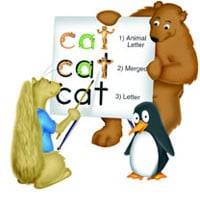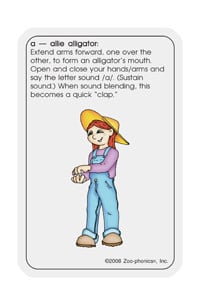Zoo-phonics Will Reach Every Child
Toddler
Preschool
Kindergarten / First Grade
Grade School (Struggling Readers)
Special Needs (All Grades)
Home School
Children are so ready for learning, however, it is difficult at best to teach them through abstract methods and materials – they do not understand abstractions. Make it concrete, however, and there is no limit to what they can learn.
The problem with learning how to read and spell is that the alphabet is too abstract. So we made it concrete! Our Animal Letters are delightful and memorable. Here’s why:
A bear is a bear, is a bear, no matter how you turn him!

Can you say this about a “b”?

The Zoo-phonics methodology fully involves your child’s eyes, ears, mouth and body as they learn phonemic awareness, the alphabet and how to decode (read) and encode (spell/write).
Zoo-phonics is so playful. Watch baby animals as they play. They are in constant motion as they wrestle, jump, roll, snarl, yip and growl. This is important preparation for adulthood. The same goes for your child. They’re in constant motion and they love to make noise. So let’s use what is natural for them and channel it for learning! If they are moving, they have fun and they are processing information through this important movement and sound production!
Zoo-phonics has a strong parent component because we know that training you to help your child is crucial. And you’ll both have so much fun as you “play” Zoo-phonics.
For Toddlers (1 and 2 years old)

As soon as you see that your child is ready to sit for a few minutes and listen to a story, s/he’s ready for Zoo-phonics! You will start by teaching the individual letter shapes and sounds of the lowercase alphabet with the Animal Letter Cards and Body Movements, which will lay the foundation for all future reading, spelling and writing.
At this young age, we recommend that you show one Animal Letter Card at a time. And then, reinforce all the letters you have taught previously with our fun games and activities. And definitely leave the Animal Cards where your child can find them easily and play with them daily!
When they’re ready, and you’ll be amazed at how quickly that will come around, you can move on to the other levels of the program
For Preschoolers (3 and 4 year olds)
You can present several letters a day, getting through the whole alphabet in a week! Yes, that’s right. You can teach the sounds and shapes of the entire 26 letters of the alphabet in a week or less! The secret is our exclusive Animal Letters and the Body Signals or Movements that go with them!
You’ll then reinforce this instruction with our fun games, music and activities. Preschoolers are in constant motion and they love to make noise. So let’s use what is natural for them and channel it for learning! If they are moving, they have fun and they are processing information through this important movement and sound production!
When they’re ready, and you’ll be amazed at how quickly that will come around, you can move on to the other levels of the program.
For Kindergarten and First Graders

Children this age can learn the entire alphabet in one sitting! After all, you are just showing them animals and doing appropriate animal “wiggles.” The secret is our exclusive Animal Letters and the Body Signals or Movements that go with them!
You’ll then reinforce this instruction with our fun games, music and activities. Moving from knowing the Zoo alphabet to real reading will happen almost magically. Children are in constant motion and they love to make noise. So let’s use what is natural for them and channel it for learning.
When they’re ready, and you’ll be amazed at how quickly that will come around, you can move on to the other levels of the program.
Grade School (struggling readers)
At Zoo-phonics, we have found that when an older child is still struggling with the reading, spelling and writing process, it is primarily because the student still doesn’t get the “code” to the English language. That’s the phonics aspect of it. S/he doesn’t know that “ai” makes 5 different sounds in words (for example), or that “ea” makes three different sounds. So, what does s/he do? She reads and spells by his/her ear – and the words are often incorrect.
What does Zoo-phonics do? We start by building the foundation, from simple to more complex – by helping the student to learn to “break the code” of the English language. We teach the various graphemes (the letter combinations that we see) and phonemes (the letter combinations we hear) directly and systematically. We work with them on the entire process of reading, which includes comprehension. We work on spelling skills and writing skills (capitalization, punctuation, grammar, sentence structure), etc.
We have the materials, games, and instructions to help you and your child master this wonderful language process.
Zoo-phonics and Children With Special Needs
While Zoo-phonics has been very successful in teaching the gifted program, regular education, immersion and bilingual classes, etc., you should know that Zoo-phonics was born in a self-contained special education class.
We have received many letters and phone calls through the years telling of how it has benefited children with very special needs. Besides developmental delays, ADHD and dyslexia, we have been told of children who, having been diagnosed as Autistic, have gotten their first sounds through Zoo-phonics. A little boy who had to be lifted to the carpet each day for Zoo-phonics practice got the first movement of his leg one day when they got to Kayo Kangaroo who “gives a kick.” We could go on, and on, and on!
Home School
What do homeschoolers find most appealing about the Zoo-phonics Program?
The joy that Zoo-phonics brings into the home classroom through the Animals, the movement, music, game format and through the ease with which the children learn the basics of reading, spelling and writing.
How is the Zoo-phonics Program used in a homeschool setting?
The presentation of Zoo-phonics is much the same whether in a classroom or home setting. Each Animal/Picture, in the shape of the letter, is presented to the child giving all three modalities at the same time: 1) visual; 2) auditory; and 3) kinesthetic. Holding up the picture, you and you’re your children say, in unison, “allie alligator, ‘a’.” At the same time, they stretch out their arms and give a clap to represent the alligator’s snapping jaws.
Which Zoo-phonics Program is best suited for home school use?
There is only ONE Zoo-phonics Program and methodology. There are, however, two different kits: the Essentials Program and the Deluxe Program. You choose the Program to match the age and/or developmental level of your children.
What makes Zoo-phonics different?
Zoo-phonics: (a) Uses 26 animals to teach letter shapes and sounds. (b) Teaches the lowercase letters before introducing capitals. (c) Teaches letter sounds before letter names. (d) Teaches a body movement, or “signal,” in association with each Animal/letter of the alphabet. These “Signals” aid memory and bring fun into the classroom. (e) Treats the alphabet as a whole and goes from “a-z.” (f) Teaches short vowels before long vowels. (g) Uses “word family” patterns to teach reading and spelling, because children are “naturals” at finding and remembering patterns.
In Zoo-phonics, we take something that is very abstract (reading) and through music, stories and games, turn it into something that is concrete and understandable to young children.
How does Zoo-phonics differ from the traditional method of teaching phonics?
Zoo-phonics teaches lowercase letters and sounds first. When these have been learned, uppercase letters and letter names are introduced. The alphabet is taught as a whole and in sequence. Zoo-phonics does not believe in teaching one letter per week. It teaches the alphabet from “a-z.” To make it fun, the children sing and move to the Zoo-phonics alphabet song entitled, “Come Meet us at the Zoo” (from the Zoo-Music Collection On CD). A Body Signal is taught from “a-z” in association with each Animal. Not only is this beneficial to a young child’s physical development, but it aids memory (for “When the body moves, the brain remembers”), and it’s fun!

